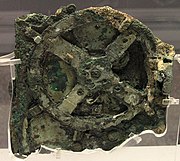Orrery
From Wikipedia, the free encyclopedia
An orrery is a mechanical device that illustrates the relative positions and motions of the planets and moons in the solar system in a heliocentric model. They are typically driven by a large clockwork mechanism with a globe representing the Sun at the centre, and with a planet at the end of each of the arms.
Contents |
[edit] History



According to Cicero, the Greek philosopher Posidonius constructed an orrery, possibly similar or identical to the Antikythera mechanism, that exhibited the diurnal motions of the sun, moon, and the five known planets. Cicero's account was written in the first century BC.
The Antikythera mechanism may be considered one of the first orreries. It is an ancient mechanical calculator (also described as the first mechanical computer) designed to calculate astronomical positions. It was discovered in an ancient shipwreck off the Greek island of Antikythera, between Kythera and Crete, and has been dated to about 150-100 BC. Technological artifacts of similar complexity did not appear until a thousand years later.
The first modern orrery was built circa 1704 by George Graham and Thomas Tompion.[1] Graham gave the first model (or its design) to the celebrated instrument maker John Rowley of London to make a copy for Prince Eugene of Savoy. Rowley was commissioned to make another copy for his patron Charles Boyle, 4th Earl of Orrery, from which the device took its name. This model was presented to Charles' son John, later the 5th Earl.
Joseph Wright's picture "The Orrery" (ca. 1766) which hangs in Derby Museum and Art Gallery, features a group (three men, three children, and a lone woman) listening to a lecture by a 'natural philosopher'—the only light in the otherwise darkened room is apparently from the centre of the brass orrery, which, in the case, has rings that cause it to appear to be similar to an armillary sphere. Shoemaker John Fulton of Fenwick, Ayrshire, built three between 1823 and 1833 - the last is in Glasgow's Kelvingrove Art Gallery and Museum.
[edit] Explanation
Orreries are sometimes called planetariums, although this word usually refers to hemispherical theatres in which images of the night sky are projected onto an overhead surface. Orreries can range widely in size from hand-held to room-sized.
Orreries are usually not built to scale. Some fixed solar system scale models have been built and are often many kilometres in size. An innovative concept is to have people play the role of the moving planets and other Solar system objects. Such a model, called a human orrery, has been laid out with precision at the Armagh Observatory.
A normal mechanical clock could be used to produce an extremely simple orrery with the Sun in the centre, Earth on the minute hand and Jupiter on the hour hand; Earth would make 12 revolutions around the Sun for every 1 revolution of Jupiter. Note however that Jupiter's actual year is 11.86 Earth years long, so this particular example would lose accuracy rapidly. A real orrery would be more accurate and include more planets, and would perhaps make the planets rotate as well.
Many planetariums have a projection orrery, which projects onto the dome of the planetarium a Sun with either dots or small images of the planets. These usually are limited to the planets from Mercury to Saturn, although some include Uranus. The light sources for the planets are projected onto mirrors which are geared to a motor which drives the images on the dome. Typically the Earth will circle the Sun in one minute, while the other planets will complete an orbit in time periods proportional to their actual motion. Thus Venus, which takes 224.7 days to orbit the Sun, will take 0.7 minute to complete an orbit on an orrery, and Jupiter will take 11.86 minutes.
Some planetariums have taken advantage of this to use orreries to simulate planets and their moons. Thus Mercury orbits the Sun in 0.24 of an Earth year, while Phobos and Deimos orbit Mars in a similar 4:1 time ratio. Planetarium operators wishing to show this have placed a red cap on the Sun (to make it resemble Mars) and turned off all the planets but Mercury and Earth. Similar tricks can be used to show Pluto and its three moons.
[edit] References
- ^ Carlisle, Rodney (2004). Scientific American Inventions and Discoveries, p.189. John Wiley & Songs, Inc., New Jersey. ISBN 0471244104.
[edit] See also
- Astrarium
- Astrolabe
- Astronomical clock
- Ephemeris
- Eratosthenes
- Planetarium
- Rees's Cyclopaedia
- Stability of the Solar System
- Tellurion
- Torquetum
[edit] External links
| Wikimedia Commons has media related to: Orreries |



